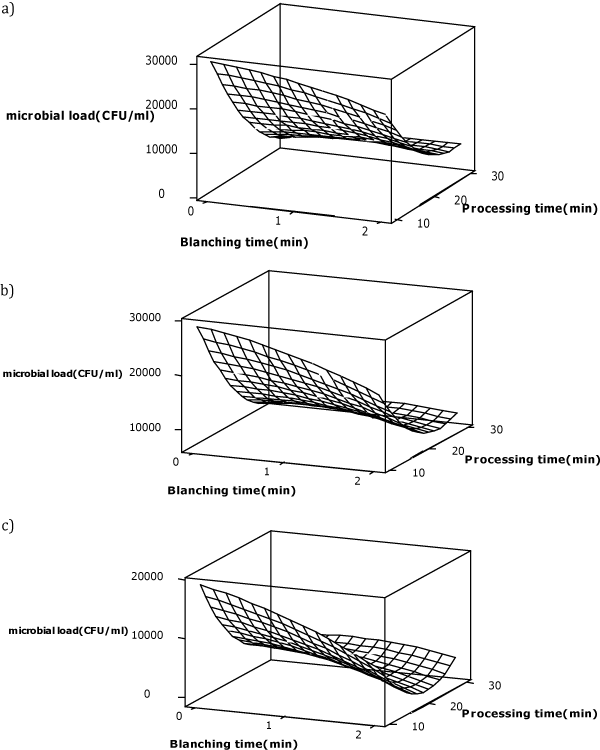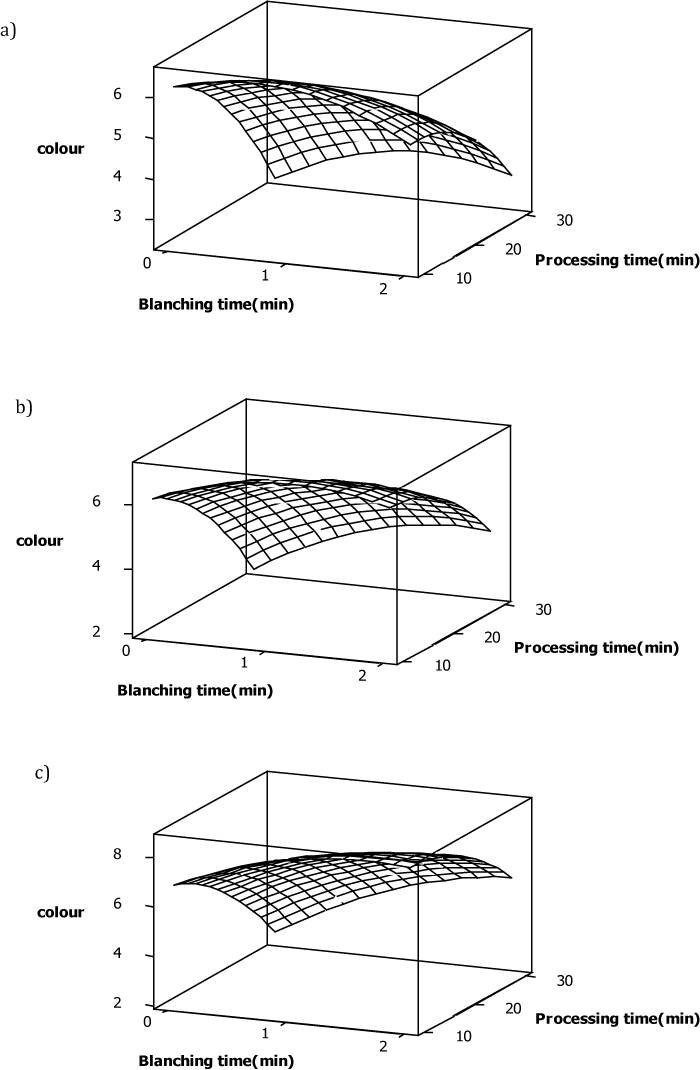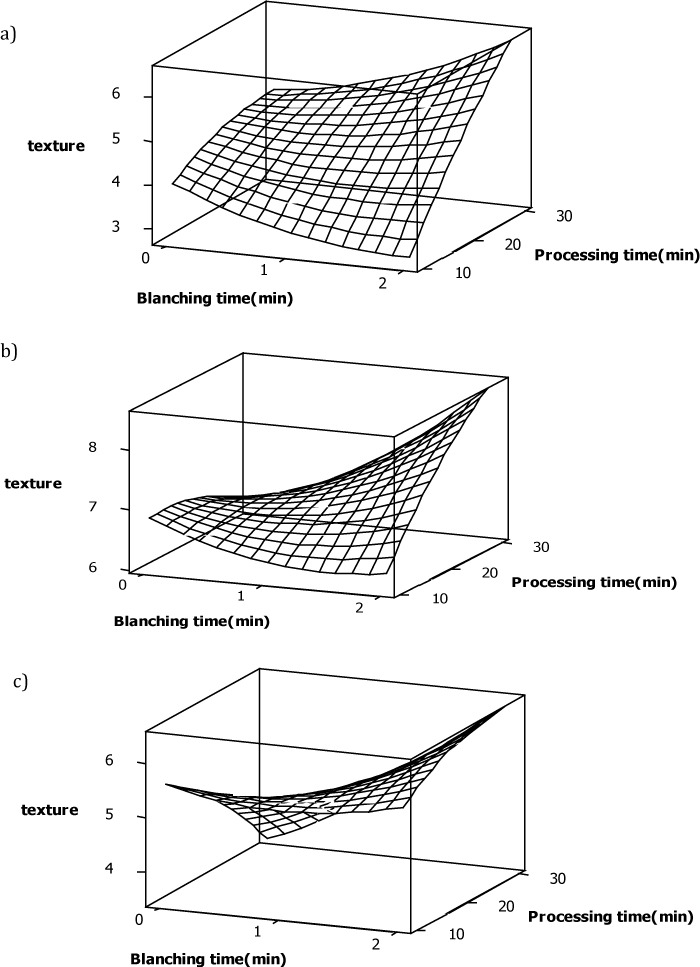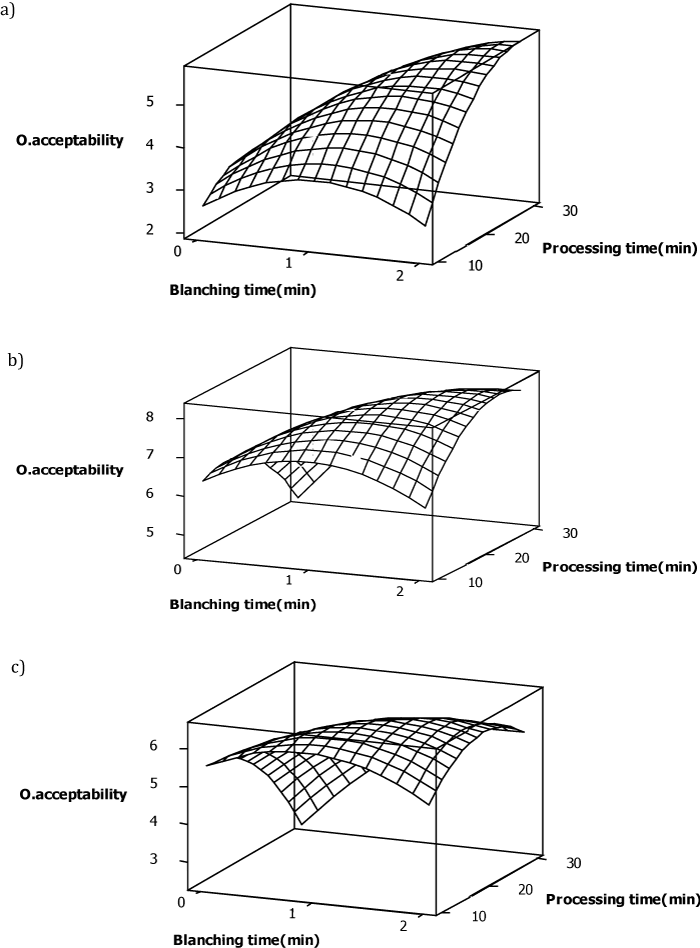Journal of
eISSN: 2373-4310


Response surface methodology and central composite rotatable design for K=3 was used to study the combined effects of blanching time, sodium metabisulphite (Na2S2O5) concentration and processing (retorting) time on the total microbial load, and sensory qualities (colour, aroma, texture, overall acceptability) of cocoyam leaves during canning. Regression models and response surface plots were developed from regression analysis to predict the effects of the variables on the studied indices. Significant (P<0.05) interactions were noted between all the factors with high regression coefficients (61.7%-94.7%). Increasing processing times led to decreases in microbial load and degree of liking for colour of the canned cocoyam leaves. Blanching was effective in reducing browning and increasing the degree of liking for colour of the canned leaves. Treatment of the leaves with sodium metabisulphite solution significantly reduced the microbial load and the degree of likeness of the different sensory attributes of the canned product. The combined action of sodium metabisulphite concentration, blanching time and processing time were effective in reducing the total microbial load as well as the degree of liking for colour of cocoyam leaves during canning of the canned product. These could serve as a means of enhancing the shelf stability as well as the overall acceptability of the product. The most acceptable product was the one blanched for 1minute, with 0.5% anti-browning agent concentration, and retorted for 20minutes.
Keywords: cocoyam, Xanthosoma sagittifolium, green leafy vegetables, microbial quality, sensory attributes, canning, sterilization
Cocoyam (Xanthosoma sagittifolium) leaves are one of the most commonly consumed green leafy vegetables in West Africa and it forms an important part of the diet of the populace. The crop is also grown and eaten in other African countries such as Gabon, Cameroon, Nigeria, and the Ivory Coast. The leaves are erect, sagittate, and with a stout petiole. Cocoyam leaves supply fibre, carbohydrates, proteins, minerals like calcium, phosphorus and iron, and vitamins like thiamine, riboflavin, niacin and ascorbic acid.1‒3 Cocoyam leaves are harvested and consumed when fresh and young. This is because they deteriorate rapidly after harvesting. They become wilted and tough due to loss of moisture when kept for some time, causing decrease in some organoleptic qualities such as texture and colour.2 This makes them unacceptable for consumption.
Vegetables and leafy vegetables are highly perishable because of their relatively high moisture content,4 and this makes it possible for microbes to survive and inherent enzymes to also act on the nutrients and cause deterioration to the vegetables through autolysis. Afoakwa5 explained that canning is preferable for processing vegetables due to its ability to maintain some relatively adequate levels nutrients and sensory attributes whilst producing a processed product which is commercially sterile, thus preventing spoilage or post-harvest losses. Thermal processing has also been used in combination with irradiation to effectively reduce the microbial load of foods. Irradiation in combination with retort processing significantly reduced microbial loads of ready-to-eat chicken pulav.6
Vegetables contain naturally occurring enzymes that are important for speeding up ripening and maturity processes. Enzymatic reactions may continue even after harvesting, most often bringing about undesirable sensory changes. During pre-processing, vegetables have the tendency to brown due to cutting, washing, bruising or other mechanical injury causing disruption of the cellular organisation of the vegetables.7 Browning impairs the sensory properties of vegetables reducing their shelf-life and market value.8 Enzymatic browning is caused by the enzyme polyphenol oxidase. It works by catalyzing the oxidation of phenolic compounds, causing the formation of brown or grey polymers such as quinones, and further polymerization into melanoidines in the presence of oxygen.9,10 In green vegetables and green leafy vegetables, heat also causes browning. This is due to the conversion of chlorophyll in the leaves to pheophytin.11,12 deMan13 stated that when a green vegetable is dipped in boiling water, the first colour change observed is the brightening of the green colour. This is caused by the expulsion of air and the collapse of the intercellular spaces. Further heating then causes change of colour from green to olive brown, due to conversion of chlorophyll to pheophytin.
Canning is one of the most effective modern preservation methods used in food industries to prolong the shelf-life of foods and food products. Its main aim is to provide a product in a condition of commercial sterility.5,14,15 This commercial sterility is achieved through the application of heat for a specified amount of time which renders the food free of viable forms of microorganisms of public health significance and also microorganisms of non-public health significance but capable of reproducing in the food under normal non-refrigerated conditions of storage.5,14‒16
Cocoyam leaves are highly perishable and also lose quality during storage. In order to reduce post-harvest losses, there is the need to preserve it using appropriate processing technologies to increase its shelf-life and also maintain its qualities. Canning technology has been successfully used to process leafy vegetables and many different foods to increase their shelf-life and quality.5,14‒18 However, various processing conditions such as processing time and temperature, blanching, exhausting, quality of seam, pressure at which the food is processed as well as the processing medium can affect the quality of the processed food in terms of its microbial qualities, sensory qualities, nutrient contents and other physico-chemical characteristics. Thus, this study investigated the effects of blanching times, sodium metabisulphite (Na2S2O5) concentrations, and processing times on the total microbial load and sensory qualities of cocoyam leaves during canning.
Material
Freshly harvested cocoyam (Xanthosoma sagittifolium) leaves were obtained from the University of Ghana Agricultural Research Institute farm on the same day of harvest. The samples were immediately transported under ambient conditions to the laboratory for processing and canning.
Experimental design using response surface methodology
A Central Composition Rotatable Design (CCRD) was used to set up using the Minitab software with experimental study variable number K=3, for independent variables including blanching time (X1), sodium metabisulphite (Na2S2O5) concentration (X2), processing time (X3). The processing time that would be used in the CCRD for K=3 was processed using the software to provide the independent variable limits and their values (Table 1). Fifteen (15) sample combinations were generated from the software in an experimental design using the design matrix and variable combinations in experimental runs (Table 2).
Sample preparation and canning of cocoyam leaves
The fresh young cocoyam leaves were transported to the processing laboratory. The cocoyam leaves were sorted to remove any unwanted and discoloured ones. The petioles were then removed using knives. The leaves were then washed thoroughly with water until all the dirt and any extraneous matter are removed. The leaves were cut into shreds using a knife. The samples were divided into three groups. Two groups were blanched at 80°C for 1 and 2minutes respectively, and the third was left unblanched. Cans were examined for defects, washed and sterilized in a jacketed pan for 1hour at 100°C. The cans were filled with the blanched and unblanched samples to a weight of 55g. The cans were then filled with respective concentration of 0%, 0.5% and 1% sodium metabisulphite concentration and 2% brine solution up to a headspace of 5/16”. The filled cans were exhausted for 1minute, seamed and retorted immediately.
Retorting was done at a temperature of 121°C at a pressure of 21 psi for 10, 20, and 30 min respectively. They were then allowed to cool at a slow rate to room temperature. The cans were cleaned coded with the following information; blanching time, sodium metabisulphite, and processing time. Further analysis was carried out after conditioning the products at normal ambient room temperature for 7days.
Analytical methods
Microbial analysis: The total plate count method was used for microbial analysis. A dilution of 1:10 was prepared by mixing 10g of the sample with 90ml distilled water. The samples were blended using a stomacher blender and serial dilution s of 10-1 and 10-2 were used. One millimeter of each dilution was transferred into a petri dish by pipette and plate count agar, which had been melted and cooled to a temperature of 48°C , was poured over the solutions in duplicates and incubated at 35°C for 24hours.19 The Stuart colony counter was used to count the number of colony forming units.
Sensory analysis:
Consumer acceptance test: The balanced incomplete block design (BIBD) was used to design a sensory evaluation for the 15 different canned samples. The block number was 35. Thus, 35 untrained panellists were used for the sensory evaluation. Each panelist was served with three samples, and each sample appeared seven times. The panelists were asked to rank their degree of liking for the colour, aroma, texture (hardness or softness) and overall acceptability on a 9-point hedonic scale where the two extremes, 1 and 9 represent dislike extremely and like extremely respectively.
Statistical analysis
Minitab software was used to set up a central composition rotatable design and regression analysis to evaluate the relationship between the dependent and independent variables to generate a regression equation. The regression equation was used to develop the response surface plots. Regression coefficients and lack-of-fit were used to evaluate the significance (acceptance or rejection) of the model. Significant probability was set at p≤0.05.
Independent variables |
Codes |
Variables levels |
||
|---|---|---|---|---|
Low |
Middle |
High |
||
Blanching time (min) |
X1 |
0 |
1 |
2 |
[Na2S2O5] (%) |
Xsub>2 |
0.0 |
0.5 |
1.0 |
Processing time (min) |
Xsub>3 |
10 |
20 |
30 |
Table 1 Process variables and their levels used in the central composite design for k=3
Sample no. |
Coded variables |
||
|---|---|---|---|
Blanching time (min) (X1) |
[Na2S2O5] (%) |
Processing time (min) (Xsub>3) |
|
1 |
1 |
0.5 |
30 |
2 |
2 |
0.5 |
20 |
3 |
2 |
1.0 |
30 |
4 |
0 |
1.0 |
10 |
5 |
0 |
0.0 |
10 |
6 |
1 |
0.0 |
20 |
7 |
2 |
1.0 |
10 |
8 |
1 |
0.5 |
10 |
9 |
0 |
1.0 |
30 |
10 |
2 |
0.0 |
10 |
11 |
1 |
0.5 |
20 |
12 |
0 |
0.0 |
30 |
13 |
0 |
0.5 |
20 |
14 |
2 |
0.0 |
30 |
15 |
1 |
1.0 |
20 |
Table 2 Design matrix and variable combinations in experimental runs
Effect of process factors on the microbial load of canned cocoyam leaves
The model obtained for the microbial load of the canned cocoyam leaves was 59541.20–3813.80X1–217.50X2–3456.20X3–1887.50X1X2+254.40X1X3+598.70X2X3– 1200.00X12–17100.00X22+52.20X32 with an R2 of 90.8%. The model could explain 90.8% of the variations in the microbial load. Only 9.2% of the variations could not be accounted for by the model, which could be due to other factors not included in the model (Table 3). All the plots showed similar trends (Figure 1). Blanching time had no significant (p>0.05) linear or quadratic effect on the model. However, blanching time had significant (p≤0.05) combined effects with processing time and sodium metabisulphite concentration on the model. Processing time had significant (p≤0.05) linear and quadratic effects on the model. Sodium metabisulphite concentration had significant (p≤0.05) quadratic effect on the model, but no linear effect. At all sodium metabisulphite concentrations, microbial load decreased with increasing processing time (Figure 1). Hubbard20 reported that the use of heat processing to decrease microbial populations is a well-established principle. The longer processing times at the high temperature (250°F) were effective in reducing the microbial load of the samples.
The level of decrease in microbial load was high with increasing sodium metabisulphite concentration. This is because sodium metabisulphite inhibited the growth of spoilage organisms by lowering the water activity in the microorganism by an osmotic process which caused the microbial cell to lose water and thus limit their growth and survival.21 Sodium metabisulphite is also used in the food industries as a preservative agent.8 It is thus not surprising that the level of decrease in the microbial load was high with increasing sodium metabisulphite concentration.
The microbial load of the canned products ranged from 2.9x103 to 3.0x104CFU/ml. A total microbial count of 107CFU/ml has been reported to be high, undesirable and indicative of food spoilage.21 Comparing this value to the range obtained in the study, it can be said that all the canned cocoyam leaf samples were microbiologically safe for usage.
Effect of process factors on the sensory attributes of canned cocoyam leaves
Colour: The model obtained for the colour of the canned cocoyam leaves as assessed by the untrained panellists was6.1614+0.4977X1–0.6046X2+0.0696X3+1.2500X1X2+0.0375X1X3–0.0250X2X3 –0.6364X12+1.4546X22-0.0064X32 with an R2 of 94.7%. The model could explain as much as 94.7% of the variations in colour. Blanching time, sodium metabisulphite concentration, and processing time all had significant (p≤0.05) quadratic effects on the model but no linear effect. At all sodium metabisulphite concentrations, the degree of liking for colour increased with increasing blanching time (Figure 2). Blanching is reported to help in brightening the colour of foods.22 It is not surprising that the degree of liking was increased with increasing blanching time. The degree of liking decreased with increasing processing time for all the three plots (Figure 2). At a lengthened heat process of green leafy vegetables, there is degradation of chlorophyll, resulting in the formation of pheophytins and pyropheophytins which are both olive brown.12 Ngo & Zhao23 also reported decrease in chlorophylls a and b concentrations and increase in the concentrations of pheophytins and pyropheophytins with increasing processing time for spinach processed at 250°F. This could explain the decrease in degree of liking with increasing processing time. Also, at 1% sodium metabisulphite concentration, the degree of liking was higher than at 0.5% and 0% anti-browning agent concentrations respectively. Thus, the sodium metabisulphite was effective in retaining the colour of the canned cocoyam leaves.
Sample 15 (X1=1min, X2=1% and X3=20mins) was the most liked product in terms of colour. This could be attributed the fact that the blanching and the sodium metabisulphite were effective in reducing browning of the product, and the processing time (20minutes) was not too much to cause chlorophyll degradation and hence browning of the product.
Texture: The model obtained for the texture of the canned cocoyam leaves as assessed by the untrained panellists was 2.9705–1.8508X1+11.1652X2+0.1248X3+0.5833X1X2+0.0708X1X3–0.1417X2X3 +0.2879X12–8.1818X22–0.0021X32 with an R2 of 79.7%. As much as 20.3% of the variations could not be accounted for by the model, which could be due to other external factors which were not included in the model. Sodium metabisulphite concentration had significant (p≤0.05) linear and quadratic effects on the model. The degree of liking for texture by the sensory panellists was higher at 0.5% sodium metabisulphite concentration than at 0% and 1% concentrations. There was a significant (p≤0.05) combined effect of sodium metabisulphite concentration and processing time on the model. Processing time also had a significant (p≤0.05) combined effect with blanching time on the model. For all the plots, texture increased with increasing processing time (Figure 3), although processing time did not have a significant (p≤0.05) individual effect on the model. Application of heat and thus increasing processing time has been reported to cause decrease in hardness of canned products.24 This decrease in hardness caused by increasing processing time could be due to the gradual disintegration of the cell membrane, the cell wall and other protective substances that contribute to the hardness of the product. The increase in the degree of liking with increasing processing time could be due to the fact that the decrease in hardness and thus the softness of the canned cocoyam leaves was a desirable sensory attribute. Sample 11 (X1=1min, X2= 0.5% and X3=20mins) was the most liked product in terms of texture.
Aroma: The model obtained for the aroma of the canned cocoyam leaves as assessed by the untrained panellists was 5.5250+0.1250X1+2.6500X2-0.0450X3+1.2500X1X2+0.0375X1X3-0.0250X2X3 -0.5000X12-2.0000X22+0.0000X32 with an R2 of 61.7%. The model could explain about 61.7% of the variations in the aroma of canned cocoyam leaves. Sodium metabisulphite concentration had significant (p≤0.05) linear effect on the model but no quadratic effect. The degree of liking for aroma of the canned cocoyam leaves increased with increasing sodium metabisulphite concentration (Figure 4). The 1% sodium metabisulphite concentration addition was effective in preserving the canned food and preventing development of off-odours, hence the high degree of liking for aroma. Blanching time had a significant (p≤0.05) combined effect with sodium metabisulphite concentration on the model. At 1% sodium metabisulphite concentration, the degree of liking for aroma increased with increasing blanching time (Figure 4C). Blanching has been reported to inactivate quality changing enzymes such as those that create loss of colour, like polyphenol oxidase that causes browning reactions or texture, off-flavour production or destruction of nutrients.15 The observation in Figure 4C was thus not surprising. Blanching also had significant (p≤0.05) combined effect with processing time on the model. Sample 3 (X1=2mins, X2= 1% and X3=30mins) had the highest degree of liking for aroma. Heat processing also causes development of flavours and aromas due to complex reactions such as degradation, recombination and volatilization of aldehydes and ketones, sugars, amino acids and organic acids.25
Overall acceptability: The model obtained for the overall acceptability of the canned cocoyam leaves as assessed by the untrained panellists was 0.3932+0.8114X1+13.4227X2+0.3023X3-0.2500X1X2+0.0875X1X3- 0.1250X2X3-0.8182X12–9.2727X22-0.0082X32 with an R2 of 62.8%. About 37% of the variations could not be accounted for by the model, which could be due factors not included in the model. Sodium metabisulphite had significant (p≤0.05) linear and quadratic effects on the model (Figure 5). The samples to which 0.5% sodium metabisuphite was added generally had high overall acceptability scores (Figure 5B). From the results of the consumer acceptability test, sample 11 (X1=1min, X2=0.5% and X3=20mins) was the most acceptable product. Sample 5 (X1=0min, X2= 0% and X3=10mins) was the least acceptable product.

Figure 1 Response surface plots for microbial load of canned cocoyam leaves at (A) 0%, (B) 0.5% and (C) 1% sodium metabisulphite concentrations.

Figure 2 Response surface plots for colour of canned cocoyam leaves at (A) 0%, (B) 0.5% and (C) 1% sodium metabisulphite concentrations.

Figure 3 Response surface plots for texture of canned cocoyam leaves as at (A) 0%, (B) 0.5% and (C) 1% sodium metabisulphite concentrations.

Figure 4 Response surface plots for aroma of canned cocoyam leaves at (A) 0%, (B) 0.5% and (C) 1% sodium metabisulphite concentrations.

Figure 5 Response surface plots for overall acceptability of canned cocoyam leaves at (A) 0%, (B) 0.5% and (C) 1% sodium metabisulphite concentrations.
Terms |
Regression coefficients of the response variables |
||||
|---|---|---|---|---|---|
Microbial load (CFU/ml) |
Colour |
Texture |
Aroma |
Overall acceptability |
|
Constant |
59541.20* |
6.16* |
2.97 |
5.53* |
0.39 |
Blanching Time (X1) |
-3813.80 |
0.50 |
-1.85 |
0.13 |
0.81 |
[Na2S2O5] (X2) |
-217.50 |
-0.60 |
11.17* |
2.65* |
13.42* |
Processing Time (X3) |
-3456.20* |
0.07 |
0.12 |
-0.05 |
0.30 |
X1X2 |
-1887.50 |
1.25* |
0.58 |
1.25* |
-0.25 |
X1X3 |
254.40* |
0.04* |
0.07* |
0.04* |
0.09* |
X2X3 |
598.70* |
-0.03 |
-0.14* |
-0.03 |
-0.13 |
X12 |
-1200.00 |
-0.64* |
0.29 |
-0.50 |
-0.82 |
X22 |
-17100.00* |
1.45* |
-8.18* |
-2.00 |
9.27* |
X32 |
52.20* |
-0.01* |
-0.00 |
-0.00 |
-0.01 |
R2 |
90.8% |
94.7% |
79.7% |
61.7% |
62.8% |
R2 adjusted |
89.2% |
93.8% |
78.8% |
54.8% |
56.1% |
Lack-of-fit |
2533.2 |
0.3843 |
1.755 |
0.7756 |
1.696 |
Table 3 Regression analysis of the response variables with the processing factors
*Significant at p≤0.05
All the processing factors - blanching time, sodium metabisulphite concentration and processing time had significant influences on the microbial and sensory qualities of the canned cocoyam leaves. Increasing processing times led to decreases in microbial load and degree of liking for colour of the canned cocoyam leaves. Blanching was effective in reducing browning and increasing the degree of liking for colour of the canned leaves. Treatment of the leaves with sodium metabisulphite solution significantly reduced the microbial load and the degree of likeness of the different sensory attributes of the canned product. The most acceptable product was sample 11 which was processed using blanching time of 1min, sodium metabisulphite concentration of 0.5% and processing time of 20mins. The combined action of sodium metabisulphite concentration, blanching time and processing time were effective in reducing the total microbial load as well as the degree of liking for colour of cocoyam leaves during canning of the canned product. These could serve as a means of enhancing the shelf stability as well as the overall acceptability of the product.
Author declares that there is no conflict of interest.

© . This is an open access article distributed under the terms of the, which permits unrestricted use, distribution, and build upon your work non-commercially.